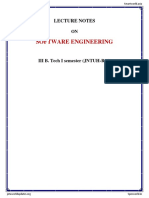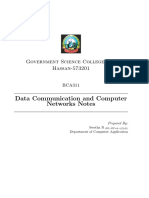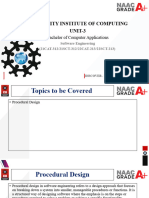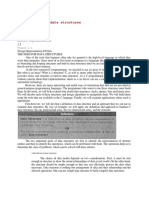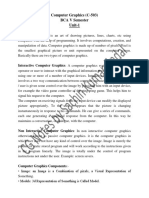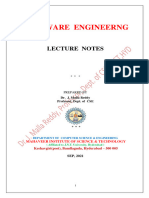100%(1)100% found this document useful (1 vote)
6K views66 pagesSoftware Engineering Notes BCA 4th Sem
Software Engineering proper notes according to BCA syllabus
Uploaded by
Akash ShuklaCopyright
© © All Rights Reserved
We take content rights seriously. If you suspect this is your content, claim it here.
Available Formats
Download as PDF or read online on Scribd
100%(1)100% found this document useful (1 vote)
6K views66 pagesSoftware Engineering Notes BCA 4th Sem
Software Engineering proper notes according to BCA syllabus
Uploaded by
Akash ShuklaCopyright
© © All Rights Reserved
We take content rights seriously. If you suspect this is your content, claim it here.
Available Formats
Download as PDF or read online on Scribd
You are on page 1/ 66
Qe 1s “What do yo mean by Software ? ;
Ans. Sometimes abbreviated as SW and s/
N; software is a collection: ‘of. instructions that enable the user:
o interact, with .a computer, its hardware; or perform tasks.
Without. software, computers . would be’ useless. For, example,
internet browser, you could’ not surf. the ‘Internet ».
or read ‘this page and without’ an operating. system, the browser
could notrun on your computer. The picture to. the. right
shows a Microsoft. Excel - bor an example. oF a Pereadeheet
software pregram.. ” ‘ Programming Paradigm ': This paradigm is related
osely to programming aspect of software development. This
cludes, ape te ‘ wi aN KeaRE
@ Coding
Gi) Testing
(Git) Integration,
(ae TRS MARS. | WR RRS RcARE) AVRO s |
‘Ans. Waterfall Model
“Waterfall Model’. because of its diagram
matic représet ‘resembles a cascadé iof waterfalls.
1. Requirem ‘analysis and specification phase : The
goal of this to, usderstand the exact requirements of the
ent them. properly.\ This activity i is usually
2 as the goal is to document
all functions): p ca ‘and interfacing requirements for the
. The requirements describe the "what" of a system, not
=. Implementation and unit testing PHase = lee thy
Phase, design tis implemented. ‘If the SDD os Sheen > th
implementation or coding phase proceeds soo _ecause 5
the information needed by the software development is contaj,,
in the SDD. A
During testing, the major, activities are centered around {), :
etamination ‘and modification of tie -code. Initially, small mody,
are tested in’ isolation from the rest) of ‘the software produg
These are problems associated with testing a module in isolati,,
How do we run a module without anything to call it, to be calle
by it or, possibly, to output intermediate values..obtained durin, ;
execution ? Such problems are: solved in this phase and modu}, :
“are, tested after writing some: overhead code. -
4. Integration and . em testing phase
important phase. Effective ‘will co:
of higher quality’ software products, ‘more users, lowe ,
maintenance costs, and more ‘accurate and reliable results. It i,
a very expensive activity an consume§, one“third to one-half ¢! 7
the cost of a typical development, Project) : €
As we know, the purpose of unityfesting is to determine tha
each independent module is. (correctly implemented. This give
little chance 'to determine ‘that ‘the interface -hetween modules itz
also correct, and for thif feason integration testing is
System testing involves\the testing of the entire system, whereati
software “is apart ofthe system. ‘This is ‘essential to builic
ence i ‘developers before Software is delivered to the
in the “market. ‘
ee is a task that every devel
- Software ‘is delivered to the ¢
operational. ' Therefore,
spent and effort ‘required
release is very ‘significant,
that it is a very!
e poorly managed’
lobody. wants :
Software maintenance i
error: correction, enhancement of nab;
ity that includes
letion of obsolete
str Vantimizatnon.' ihe fr se. Of. this phase 15 to
ilities, and’ optimization. ine purpose’ eae ase
sea value ‘of the software overtime. This phase may
y ‘ ) years whereas devélopment may be 1 to 3
of "define ‘before 1d “design ‘before’ ‘code". This. model
expects complete fe'requirements early. in' the process,
waterfall. model, but ‘these: may,
‘useable ‘product is released atthe |
ach'-reléase ‘providing additional fax onali
juire nalysis ‘phase, customers and
many requirements.’as Possible ‘and ‘prepare,
evelopers and customers then prioritize these”
ers. ~
jon of users. ASteae ae
ere are four phases in this model
“With active participation of users
Requirements, We: User i ‘
inning (description, [7 , e
f Requirements planning phase, : Requirements “are
captured using any group clicitation. techniquel. Only issue is the
for unders-anding the project.
active; involvement of, users
User description |: doint teams’ ol) developers ‘and : users
stituted to. prepare, understand’ and’ review the
ents, The team may use automated tools to capture
‘ation from the: other users. © el 5
“SOS Construction phase : This phase ‘combines the detailed
design, coding ‘and testing phase of ‘waterfall; model. Here, we
release, the product to customer; It is'iexpected to use code
generators and other {types :of productivity
generators), screen
: This phase ‘incorporates acceptance
ion of the system, and user: training.
typing Model. , (2016)
stotyping Model i
jaterfall model is that the working
ite in the process, thus: delaying
alternative to this is “to first
e software insted/Of, developing
totype is devéloped as per
illy, it¢has limited functional
Refinement of.
-requirements as
per suggestions
[Implementation and Unit testing]. |
Integration & System testing |]
lm Prototype Model
The developers use this, prototype 10 Feimhe Ve Dduiremens,
and prepare the final specification docunient. Because the work,
: juiated: by thi customer, it is reasonabj. th
expect that the resulting specification document will be corre,
When the prototype created, itis’ reviewed: by the castome,
‘Typically this ‘revi e8 feedback to, the developers that be,’
to remove uncertainties: in the requirements of the software, 3;,;
starts an’ iteration ‘of refineinent | 4 ler to further Claris,
Tequirements as shown in Fig!
x i Ra é but is. not suita).
saa) e extr:
atof an
quality software, ‘This miodel. requires
involvenient oft thie customer, which is no}
"prepared when’ something unforeseen happened. Barry Bochm
\ recognized \this and tried to incorporate the “Project risk" factor
into,a life cycle model. The result is the spiral model, which was
presented in 1986 [BOEH86, sy and is ‘shown in Fig.
The redial dimension, of the model represents the curaulatiye
cxets. Each path around ‘the spiral is indicative of increased costs.
lar dimension represents the progress made in’ completing
planning: is eee risks are
and customers evaluate the
é operation or
Davalop, verity
Late moe
. An-important: feature: or’ the spiral Teves, Plage
is completed with a ‘review ‘by’ the people concerned with th,
project’ (designers and. progratnmers). This review consists of 4
review of all ‘the products developéd up to that ‘point and include,
the plans for the next cycle. These \plans ‘may’ include a Partitio,,
of the product in’ smaller portions for development or. component;
that are implemented by. individal ‘ groups or persons. If the plan
for the development fails, then the spiral is terminated. Otherwise,
i S| initiation ‘of new or: modified. software.
The advantage: of this model is ‘the wide range of: options to
accommodate ‘the good: features. of other life. cycle models. It
becomes equivalent another life’ cycle; tmodel in appropriate
situations. . It. also
The ‘spiral “model has’
resolved before. it can be a
These difficulties ‘include Kk ‘ee r idance in
determining objectives, constraints, alter ; ‘ri
assessment, expertise; and Providing ,
-for many applications. i
Q. 14; Explain the ad 2
different models.
(2) Each Phase “has well defined inputs
(3) ‘Helps, project manager in proper plannin;
a ‘Provides a. template into. which meth
c code, test and support can be placed...
es of Classical Waterfall Mod
e\ disadvantages of classical: waterfall model”: “:;
@ One way. street (sequential in nature).
“ (2) It’ ‘lacks overlapping and) interactions among ‘plies:
» 8), Usets have little interaction’ with the project team.
@ Model), does not support, delivery ‘of system in pieces.
(5):-Not suitable: for new projects ' "because of uncertainty ° ‘in
the specification. ‘i
Advantages of Iterative Waterfall ‘model : The eevee
of interative: waterfall model are given, below ;
feedback’ nee ee and -hence in: nov
wd for. project in which! requirement are not
well understood.
(3) Easy error: corrections :
Disadvantages: of: Iterative ‘Waterfall odel : Following
are, the: disadvantages of iterative waterfall
@ It: is harder ‘to. manage this model: .
No‘ clear ‘milestone’ in‘ the development. process.
vis really: finished (until the system is no longer *
I ‘ate. user requirements are . obtain iN
r participation, and support ee eustomier
implementation compromises in:
3 quickly...
) The’ ‘developer and cases: between : understand end
, to risks ‘at each evolutionary. level.
“Disadvantages of © Spiral « Model: Following are. the
disadvantages ‘of spiral model: : +
(2) It is difficult ‘to convince customer that the evolutionary
approach i is controllable.
(2), Model requires expertise in risk ‘management and éxesttent
agement, skill.
(3) Use of the model ' may be expensive anid ‘even unaffordable.
rea
Q. 15. Distinguish pebween gener
software ee y
Ans.
“The text in bold in
_ that type of software f
Custom software
Good fit: It will’
Gites: ee COMiseg
Th e application thay take months or
even years to develop
New staff will need to be trained to
use ithe custom software, leading to}
added ‘costs and time taken up for
the training.
Lower training coats, You can}
expect now staff to be able to use|)
A \genoric .package immediate!
i For inatanco, how. to | use
popular word
application’:
. processing |;
Ma RY
Custom’ file’ formats) or having’ to] Simpler to: upgrade: Suppliers
write‘ new’hardware drivers may | continu: develop, ,. their
maké upgrading more difficult and|software)\and. periodically, offer
certainly more costly thain a'generic| the next version.
er of the software is often | Future ‘proofing. Much of the
fall company and so if they | géneric applications are produced
et taken’ ‘over, then |'by maasive corporations that are
vare may no lotiger| legs likely’\to fail. And even if
they are) taken. over, then the
| new. company, is very. likely to
t isting customers.
“L Software specification, Th th
» In thi
the pranas and Constraints on its operation must be defined: _
; are. design and plementation. The software that
meets the specification’ is
meets is ‘prod;
... 8, Software validation, Th
that it has all the functionalities
ap \,
we
Q. 17. What is Software Development Laraogie sD ILC) ?
(2016)
Ans. _ Software: Development siete (SDLC)
SDLC is a process followed for ‘project, within a
software organization. It consists of. led plan describing how
to develop, maintain, replace an ce specific software.
The life cycle defines a dt fou tinproving the quality of
software and the PS at process, —
ew
The following figuré|is & graphical/represemesuss vt eNe Vario,
“Stages of a typical SDLC: | : :
fine ‘and document
m."appréved. from the
be tne itocck” shes
s ition, document: which consists
duct requirements to ‘be désigned Bhd “Goveloped
Gproject life ‘cycle. hie oes st j
‘Pesigning the product’ architecture : SRS is
»product architects’ to¢ome out with the best
e product to be developed. Based on the
ied in’. SRS, usually more than one design
oduct architecture is proposed and documented
jocumént Specification.
iewed by all the important stakeholders and
parameters as risk assessment, product
budget and time constraints ,
elected for the product.
early, defines ,\all the . architectural
‘with its communication and data
ternal and third party medules
sdules: of thegpropbsed
.
the minutest of the
c
th
gramming tcols like. compilers,
: t generate the «code.
ges such as C, C++,
g. The. programming
ype of: software being
ating the Product : This stage is usually a
e. ‘stages as''in'the ‘modern SDLC models, the
oe (Wities are mostly involved in all the stages of SDLC. -
product ‘whists stage'tefers’ to ‘the testing \only ‘stage of. the
retested, Teer froducte defects are reported, tracked, fixed’ and
Product reackies the quality standards defined
; eployment in the Market and Maintenance
201 yment in the Market, anc e
mae teecerttvet ‘is tested’ ‘and ready, tobe deployed it ‘is
‘deployment: ‘hat y in the appropriate market. Sometime product
strat s 8 as. per the organizations. business
ifiret he rolaaced in a ‘limited
&. 2. sxplain: characteristic of a Good SRS,
Ans. Characteristics of a Good SRS
"Po properly satisfy the basic goals, an SRS sh
certain properties. and. should contain different types
requirements, A good SRS is : ;
(i) Correct |
Gi)-Complete.
(iii). Unambiguous
(iv) Verifiable
(v) Consistent ;
(vi) Ranked for importance andor © stability
(vii) Modifiable fina 4 ‘
(viii) Traceable. ; Oo s
An SRS is correct if every requirement mena i in the
SRS Yepresents something .required in the final system. An
SRS is complete if. everything the’ softw.
and the responses of the software total’ classes.
are specified ‘in the SRS. Co:
hand-in-hand whereas correctne:
is done ‘correctly,. complete
indeed specified. Correctnes
than completeness of software development ‘cycle. And document is
known as the Software equirements specifi ion. (SRS). SRS
completely describes what the proposed software system should
be without describing how the software will do it.
In ‘systems Engineering and _ software. Engineering,
Requirements Analysis: encompasses those tasks that go into
determining the needs or conditions to mect for a new or
vaking® account of the possibly conilicting
he various stakeholders, such’ as: beneficiaries
neering, It is sometimes referred to proposely
quirements gathering; requirements capture,
or requireme! specification. The term requirements analysis
can, also be, applied: specifically to the, analysis proper (as
opposed to dicitation’ or documentation of the fequirements, for
* instance), '
uirements maust be actionable, measurable , testable,
user to ole
meee a
ation or
requirement
, describe ‘the complex
behaviour, of, the ‘proposed ‘oftware. Requirement
ysis involves number of, Suggestions uch a
Gi) Set the * ‘priorities “ of ion
» (iv) Functionally: ‘decompose the requirements
(v) Record the
Fequirement
ee (vii) Reduce ithe comple:
we
Q. 7. What do you, understand by analy2ms Problen)
alyzing a Problem
The basic purposé of problem analysis is to: understand {,,
problem and its, const ‘aints. Its main ‘aim is 'to\understand the
the users, what. they. want from the
system. Analysis leads to the actual: specific tion. It involves
interviewing the ‘clients and the end users. The existing
documents,clients.and ‘end users become ‘the mian source of
information for the analysts. There are a ‘number’ of methods
We will discuss a few ‘among’ them like
methodology. The ‘info
“interaction. with’ the
system ete. It ‘uses:
and the system ° model * are) “puilt? i in theminds analysts
and it is directly translated to SRS: Once se me of the
SRS is ready,:it' may -by. ‘used in fee
2. Structured analysis:': ‘This,
functions perf ‘med in the’problem, ; lata input
and output the: 3 furictions: it is A top:down ‘peti ment:
it helps. an lyst ‘to decide upon the ope. 0
s be obtained a my 0!
jany “problems associated» witl
cluding problems in defining the
in. fostering understanding ‘amo:
ies affected: by the development of
‘oblems'in dealing with ‘the volatile nature of req
ese problems: may lead ‘to poor requirements’ ‘and
cancellation of system development, or else the evelopment of
a system that is later’ judged unsatisfactory or unacceptable,
has’ high maintenance costs, or undergoes frequent: changes. ,
By improving requirements elicitation, the requirements
engineering process can be improved, resulting: in enhanced
system requirements and potentially a much better system.
Regerementiiet ‘engineering can be A ees into the activities
of require: ents. elicitation, Specilication and .validation. Most: of
nts, eachniques: and..tools today. focus: on
representation of the requirements. This
instead on ‘elicitation, concerns, . those
ements engineering that’ are not adequately
ation techniques. In elicitation methodology
‘dle. - these concerns. This new. elicitation
ing: requirements elicitation: These
, Tequirements gathering, evaluation
and. integration. Taken by
fic’ ustomer a where. the
tio’ gathering is an art: and ‘a science. The approach
mer ‘in which. informatio: is gathered require: person,
common sense, and: knowledge of. what ‘and
when. to gather ‘and: pping-stones.
eeds to be.
“: 2. Way Vesign is Important ¢
Ans. Importance of; Design
A ‘good design is’ the key to successful, product. Almos
2000 years ago Roman Architect’ Vitruvious’ recorded th,
following attributes of a good, design : : 1
@). Durability : ‘ ;
_ Gi) Utility and. Rr
ii), Charm.
K “A well-designed system is) easy. to ue understandab|,
and reliable and. allows for smooth evolution.: Without design
we risk: building an: unstable system :.\.°
“co @) One: that, ‘will, fail when: small changes. ‘are made
) One that will, be difficult'to maintain...) :
Gi): One whose quality , cannot to; assessed ‘until late si A th
software | process.
.\ ‘Therefore, : software. design should contain g Gtiien
complete, accurate: ‘and precise solution toa able in orde
to ‘ensure ‘its quality implementation:
\<, There ‘are ‘three characteristics: that serve» asa guide fo
the evolution of a. good: design: ¥ ah
as s, all, of the’ explici
‘wiodel ‘and ‘it mus
re. are many definitions of the term "module".
jm “a module is a FORTRAN subroutine" to "a modul
an Ada’ package" to "procedures and functions of PASCA
, and C*, to."C++/Java Classes", to "Java packages" to "a modul
‘4s a work! Lassigment for an individual programmer”. A!l ¢
these definitions are correct. A modular system consist of wel
defined, manageable units with well defined interfaces amon;
the’ units. Desirable properties of a modular system include
(i). Each module is a well defined subsystem that i
potentially usefull in other application. .
Gi). Each module has a'single, well defined Pe
(iv) “Modi ean tbe ‘of er modules, ie
(v) Modules should be easier to use than to build.
3 Id be simpler, from outside than from
the inside: )
Modularity is the “angle ‘attribute of ashes ‘that allows a
Program to be intellectuall ‘manageable. ,It' enhances’ design
clarity, which in turn'eases implementation, debugging, testing,
documenting, ‘and maintenance of ‘the software product.
A: system. is considered’ modular, if it consists of discreet
cm can: be implemented
on other components. Hei
to what extent we shall'mo
grows, “the effort associated with’
grows. Fig. established the relatioh
number’ of modules’.in ‘a ‘software:
‘Module Gountine ‘ :
pling is the measure of the’ degree of. tardependence
modules.’ ‘Two niodules with nee coating are ‘Strongly
* i! Nerves, -20dul,,
interconnected and thus, dependent’, on ra ale
with low coupling are‘ not ae a one’ another. “Lo,
- coupled” systems are made up of mocules wh ly
independent. "Highly coupled’ systems Laenithy La dea} M
dependence between modules. For example, if. modules m),,
use of shared global variables. Uncoupled' modules have 1
* interconnections at all; they are, completely independent a
shown in Fig:
\. @) Loosely ‘coupled : some \
a dependencies
have more. errors: Loose ‘coupling, onthe other
‘ ad, minimizes the interdependence amongst. modules. This
can be, achieved in‘ the following. ways : *
i) Controlling the number of parameters passed amongst
modules: et Pe : Ra wy
(ii) Avoid. passing undesired data to calling module.
Gii) Maintain Parent/ Id relationship between calling and
called modules... \ any
(iv) Pass data, not the ‘control -information.
. below, demonstrates two alternative design tor Sete
ident record in ‘a’ "Student Information System".
Student
b Student.
S Sen Student ID record EOF
‘Tecord EOF
Retfieve
student
Fi 4
sign demonstrates tight coupling wi gh
I : udent SS,
‘ in 2 uous
ecessary increa v atc the
performance/efficiency. :
xplain: types. of ‘coup!
; common, external,
coupling from lowest
of ways in- ‘which they | can ‘be “Coupled
1, Data Coupling The dependency between module A
vand B is said to be data: ‘coupled’ if their dependency is based
- on\the fact they communicate by, only passing, of data.’ Other
. communicating through data, « the two’ modules. are
ndent. A’ good strategy is to ensure that ‘no’ module
nication contains . “tramp data”. In Fig. above :students
address, course are examples of tramp data that are.
arily communicated between: modules. By ensuring
~ that modules communicate only,
dependency is’ mi Nt
2. Stamp ‘C ing 2. Stam
module A ahd B when: complete’ data’ st
r, Since. not all,
structure ‘are usually necessary ‘i ¢
modules. stamp .coupling typically\involy
procedure only needs a part of, a data structur
should, pas8 just t part, : ot. the co apleti }
8. Contro!
said to be
control ‘coupled of contro}
informatios:. ans of flage
‘the’ dependent
‘This is is basically ated : i ‘ternal tools
and devices. . ; : i
which -access that data t¢ rea io the:
-\éommon_ coup) ig, ite:
having
module is responsib! for,
Increment V1"
“Module Z.
Fig. : Example of ommon | coupling
“Module X
module A changes data of moa Boo
branches into D,
control of C.”
‘ig. : Example of conent coupling |
Q. 12. Describe the various strategies of design ?
Which design strategy is most popular’ and pr:
x0 one)
plan is chalked out to find
implementing the intended\sdlu
There are multiple ny:
study them briefly % 4 ear
L NOS : Structured design is a
conceptualization, of problem into several well-organized clements
of solution, 4s \basically concerned with the solution design.
Senent of structured. 1.18, It: gives better, undeness Ss
how the problem is solved. Structured ign..also makes
it simpler for designer,to conce! problem more
accurately. Y 4
Structured design, mostly | ‘based o am -gonquer’
strategy where a problem is broken into. galt ca | Lpreblems
and each small problem is individually. solved ‘un e whole
problem is solved. 1 ead by. ea oF
The small’ pieces. of problem; are, .60lv leans
solution modules. Structured design phasis. i es
be well organized, in order ei ‘precise
‘These modules aré arran
with each other. A A good
natter and program/functions work, ‘on’ input ‘rather than ona
‘tate.
Design Process : (a) The whole Sun is seen. as how
ata flows in the system by means of data’ flow
(b) DFD flepices how functions canes, data’
itire system. |
state of
Th ON ee. oelitally broken down into: smalier
as functions on the basis of their operation in ‘the
“\@) Bach function is then described at large:
3. Object Oriented Design : Object oriented design’ works
around the entities and their characteristics instead’ of functions
inv in the software system. This design strategies focuses
on etitities and its characteristics. The whole concept of software
m: revolves around the engaged entities.
a us “see the. impor telat concepts ‘of, Object Oriented
Te ‘Objects : All entities involved’ in the solution design
are: ‘known as objects. For example, ‘person, banks, company .
and customers are treated ‘as’ objects. Every entity ha3\some
ciated to it and has some nethods to perform on
(b): Classes + A clase isa
object. ‘An’ object is an ‘instance
attributes, which an ‘object..can haye
defines the functionality of the “object, \
In‘ the ; solution * design, attribute: are storéd. as variables
and - functi alities'\ are defined means, of. methods or
OD, the attributes (data variables)
the data), are bundled together is
ical manner where’ thé lower or sub-classes can
import implement and ‘re-use ‘allowed variables and methods
from their immediate super’ classes: ‘This property of OOD is
known as inheritance; This makes’ it’ easier toa define specific
class and to create’ generalized’ classes from‘ specific ones.
(e) Polymorphism : OOD languages provide a mechanism
where methods performing similar tasks but vary in arguments,
can be assigned same name. This is’ called polymorphism,
which allows a single interface performing tasks for different
types. Depending upon how the function is invoked, wepernve
Portion of the cvde gets executed.”
Q..1, Explain the Design Principle.
Ang... 4, Design Principle .. ;
‘The design ofa system is correct if a system built precisely
according .to the design satisfies the requirements of that
system. Clearly, the goal during the design phase\is to produce
correct designs. Howéver, correctness is not the sole criterion
“during.the design phase, as, there’ can be many correct designs.
‘The ‘goal. of ‘the design process. is not simply to produce a
design for the’ system. Instead,. the goal is. to find .the best
< possible «design; within the. limitations imposed by the
requirements: and the. physical. environment in which
ave ‘to: specify: some”
for), evaluation. Idi
‘A design’ should ‘clearly be Yerifial
all the specifications), and trateable (.
traced to. some: requiremet 8 evi
properties that con r
_Efficiency of any
scarce resources ‘by
due ‘to cosh, €OnSiderations.. If some. resources ‘are .s
itis‘desirable that those resources.be uscd efficiently.
: r systems, the resources that. are most often
consid: red ‘for. efficiency are processor, time and memory. An
ep yen is one that consumes less processor time and
requires less memory. In earlier days, the ehicient use of CPU
and memory was important due to the high cost of hardware.
Now that the hardware costs ‘are low compared-to the software
costs, for many software systems traditional efficiency concerns
now take a back seat compared to other considerations. One of
the exceptions is real-time systems, for which there are strict
éxecution time constraints...
Simplicity 1s: perhaps the most. important quality criteria for
software systems. We have seen that maintenance of software is
usually quite expensive. Maintainability of software is one of the
we have established. The design of a system is one of the most
factors affecting the maintainability of a system. During
tenance, the first step a maintainer‘has to. undertake is to
‘understand the system’ to be maintained. Only after.a maintainer
thorough understanding of the different modules of the system,
they are interconnected, and how modifying one will affect the
others’ should the. modification be undertaken. A simple and
“understandable design will go a long way in making the job of the
taines asier. 5
to increase efficiency of a system result in making the System
rs compler. ‘Therefore, design decisions frequently:invglve trade-
designing is fundamentallya re activity, it cannot be reduced
nebe that, can be simply: followed, sponge guidelines
. Of: introdut ing ‘errors duis design. The principles
form the: basis for most’ of the design methodologies.
noted ‘that the principles that can be used in design
those used i in problem analysis. In fact, the methods
because in both: analysis and design we are essentially.
of | the problem domain, while in design we are constructing a model
for the solution domain: Second, in: problem analysis, the analyst
has limited degrees of freedom in selecting the models as the problem
. is given, and modeling has to r>present it. In design, the designer
“has a great deal of freedom in deciding the models, as the system
*the designer is modeling does not exist; in fact the designer is creating
a model for the system that will be the basis of building the system.
That is, in design, the system depends on the model, while in Broblers
analysis the model depends dinted out
earlier, the basic aim of 1 lysis is to
understand, while the: optimize
though
ivities
(in our case, simplicity'and
the basic principles and techniqui
ne
Q. 1. What ‘do you
(by, BOnEWar
SENG Ae: Vip tca hal balay thy
Ans. Software ‘Maintenance ; sdk
Software maintenance is widely accepted part of SDLC now
a - days. It stands for all’ the modifications and updations
lone after the delivery of software product.’ There ‘are number
f reasons, why modifications are réquited, some of them are
Tiefly mentioned below. : ice ae
(1) Market Conditions ': 'Policies}‘which. changes over the
me, such as taxation and newly introduced constraints’ like,
ow to maintain bookkeeping; “May trigger need for modification.
(2) Client Requirements : Over ‘the’ ‘time, ‘customer may
sk for new features ‘or functions in the software. js)
(3) Host Modifications : If any. of the. hardware aiV/or
atform (such as operating system): of. the target host ‘changes,
ftware changes are ‘needed to keep adaptability, ‘Nw
(4) Organization Changes : If there is any ‘business level
ange at client end, such as Teduction of.organization strength,
quiring another company, organization, v turing into new
siness, need to modify in the original software may arise.
Q. 2. Explain different types hmaintenance. ' (2016)
Ans. -. Types of Mai ance ht 8 ‘
In a software lifetime, typelof' maintenance may vary based
its nature. It may just, a routine mainte: 3
ne bug discovere
(1) Corrective Maintenance : 'This includes modifications
l updations done in order to correct or fix problems, which
either overed by user or concluded by user’ error
(2) Adaptive Maintenance : | This includes modifications
updations applied to keep the software Product up-to date
tuned to the ever changing world’ of technology and
‘ness environment, : i : :
(3) Perfective Maintenance : This includes modifications
updates done in order to keep the software’ usable over
period of time. It includes new features,: new user
irements for refining the software and improve its reliability
performance,
Teele ee ence. >i mis includes moaiications
ns.to. prevent future problems of the, software. It.
tend: problenis, ‘which ‘are not significant at this
may (cause serious issues in: future,
“Types of Software Maintenance
- Proventve. = Corrective
yare product | continues
through ‘maintenan ‘efforts Therefore, it can be
‘software maintenance, is, needed to correct. errors.
features, port the software to new: platfc rms. etc.
4. Explain | the’: problems. x associated with
maintenance. . ‘
‘Ans. Problems Assodilited with Software Maintenance
‘Software maintenance work typically is much more expensive
than what it should be and takes more time than required. In
software organizations. maintenance, work is nostly carried out
hoc techniques. ‘The primary reason:
ice is one of the most’, neglected, ‘areas of software
. Eventhough software maintenance i is fast becoming
an important area of work for many companies a8 Ue soltwan,
products of. yester years age, still software maintenance j,
mostly being. carried out as fire-fighting operations, rather thay
through systematic ‘and planned. activities. ee
Software maintenance has a very poor image in industry,
Therefore, an organization. often cannot employ bright engineer
to carry out maintenance work. Even though raaintenanc
suffers from a poor image, the work involved is often more
challenging than development: work. During maintenance it jg)
necessary to thoroughly understand someone else's work and
then carry out the required ‘modifications and extensions.
‘Another’ problem associated || with maintenance work ig
that the majority of software products needing maintenance are
legacy -products.; i RAGS Sy
Q. 5. Explain: the. factors on which software
maintenance ‘activities depend ? { PAS AN,
Ans. Factors on which Software |
ES "Activities Depend ,
The, activities involved in a. software Maintenance project
are not unique and: depend on, sev factors such as:
(i) :the extent. of modification to the. product required
(ii). the resources available’ to, ‘thi maintenance team
: Gi)’ the conditions \ of ‘the, existing _product:\(that is how
structured it is, how well documented it is,ete.)
(iv) ‘the ‘expected!"prajett risks, ete. 9 =
D eded to a software product’ are minot
and straightforwe e code ‘can’ be’ directly modified. and the
changes (apppropri tely reflected in‘ all the documents. But
elaborate activities are required when the required changes
are not, so ‘trivial. Usually, for complex maintenance project for
stems, the software process can‘ be represented by 4
yerse engineering cycle. followed by a:forwared engineerin
eycle with an emphasis on as much Teuse,‘as possible from th¢
existing code and other documents. -~ SIS =
Q. 6. What is Software Re-engineering, ‘
Ans. Software Re-engineering
When we need to update the software to keep it to th?
current market, without impacting ite functionality, it is calle!
software re-engineering. It is a thorough process where th?
design of software is changed and’ programs are re-written.
You might also like
- Data Communication Computer Networks Notes BCA PDF100% (2)Data Communication Computer Networks Notes BCA PDF20 pages
- CBNST Notes For BCA PU 3rd Sem Based On Syllabus PDF100% (1)CBNST Notes For BCA PU 3rd Sem Based On Syllabus PDF27 pages
- Object Modeling and C++ Programming For Bca 2nd Semester PDF100% (2)Object Modeling and C++ Programming For Bca 2nd Semester PDF44 pages
- Computer Graphics & Animation BCA 4th Sem Notes Based On VBSPU Syllabus PDF100% (1)Computer Graphics & Animation BCA 4th Sem Notes Based On VBSPU Syllabus PDF38 pages
- Computer Graphics (C-503) BCA V Semester Unit-1No ratings yetComputer Graphics (C-503) BCA V Semester Unit-111 pages
- System Analysis and Design Notes For BCA 2nd Semester VBSPU100% (1)System Analysis and Design Notes For BCA 2nd Semester VBSPU33 pages
- Java Programming Notes For VBSPU 3rd Semester PDF100% (1)Java Programming Notes For VBSPU 3rd Semester PDF74 pages
- 1734787260059cloud Computing AKTU Notes Password Chaudhary - UnlockedNo ratings yet1734787260059cloud Computing AKTU Notes Password Chaudhary - Unlocked55 pages
- Design Process and Design Quality - Iii Unit0% (1)Design Process and Design Quality - Iii Unit9 pages
- Process - A Generic View: Software Engineering As A Layered Technology100% (1)Process - A Generic View: Software Engineering As A Layered Technology6 pages
- Object Oriented Software Engineering Notes BCA Degree 1st YearNo ratings yetObject Oriented Software Engineering Notes BCA Degree 1st Year31 pages
- Software Engineering Material by QiscetmcaNo ratings yetSoftware Engineering Material by Qiscetmca123 pages






